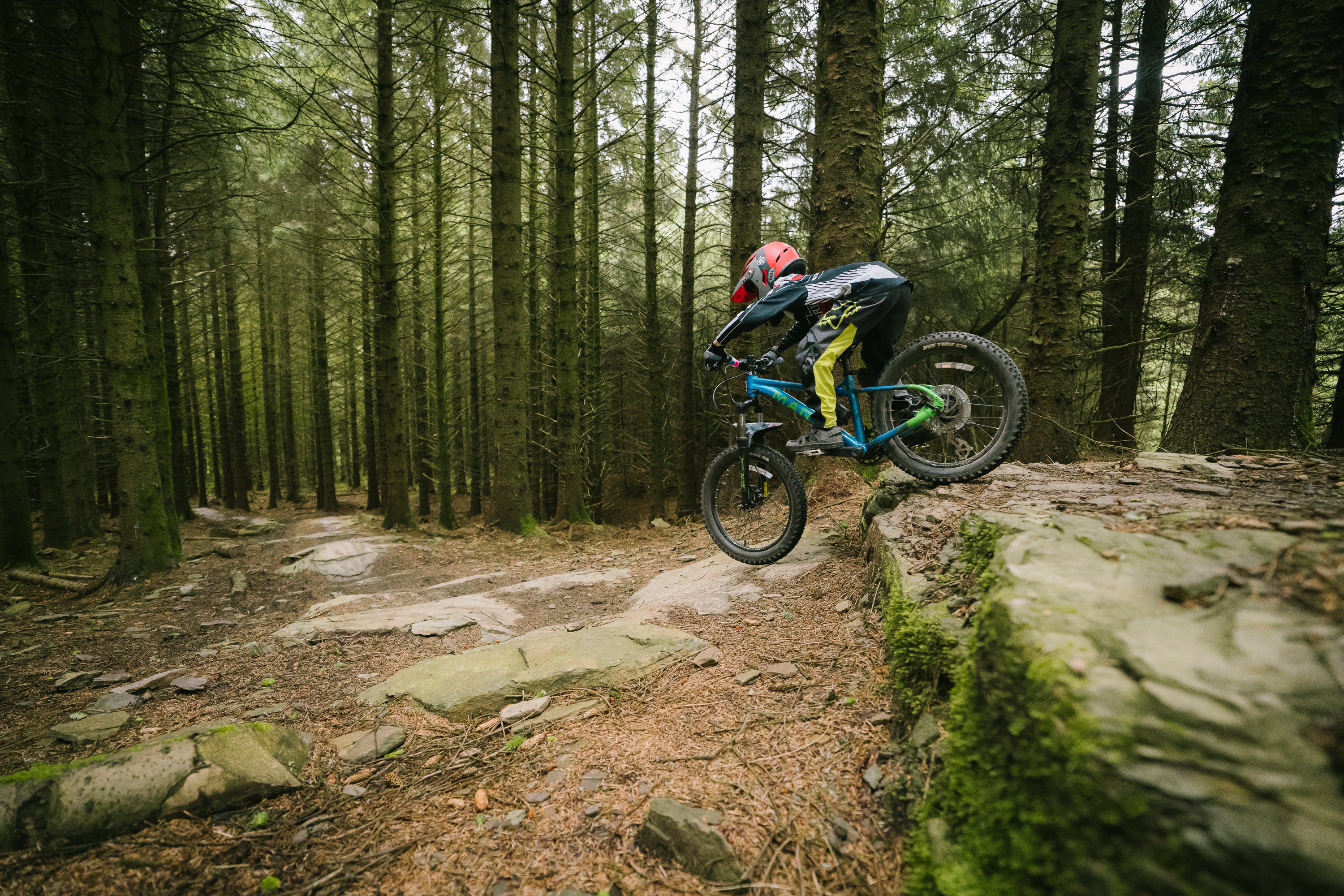Mountain Bikers Are Rewilding Land by Paying the Government to Do It

The dark spaces beneath the conifers make it feel as if the mountain bikers are emerging from nowhere. Racing down the hill, they slalom perilously close to the trees, bouncing over roots, rocks, and purpose-built jumps, their progress punctuated by the occasional, adrenaline-fueled whoop of delight.
This is Bike Park Wales, arguably the best—and certainly the best-known—mountain bike trail center in the UK. Organized like a ski resort, with color-graded trails of different difficulties and a shuttle bus uplift, the park has been a runaway success since it first opened in 2013. It now attracts upwards of 100,000 visitors every year to the former mining town of Merthyr Tydfil, with downhill enthusiasts traveling from all over Europe to ride trails like “Popty Ping,” a legendary, jump-filled blue run named after a colloquial Welsh word for microwave.
With over 40 such trails, Bike Park Wales’ owners have already turned the Gethin Woodland site, which they lease from the Welsh government, into an unlikely mountain-biking mecca. Now, this small private company is proposing something even more transformative. After a five-year renegotiation of its lease, they have persuaded Natural Resources Wales (NRW), the government agency that serves as their landlord, to embrace an ambitious nature-restoration program.
Launched today, their jointly developed “Future Forest Vision” will not only bring back biodiversity to the site, it will flip the conventional business model for rewilding on its head—showcasing a completely new way to make nature-restoration efforts economically viable. While farmers and other private landowners often receive government subsidies for rewilding, Bike Park Wales is the first example—in the UK at least—of a private company paying the government to rewild public land.
This unusual arrangement grew out of a mixture of environmental and practical concerns, according to Martin Astley, Bike Park Wales’ cofounder and director, who set up the park along with his wife Anna and their business partners Rowan and Liz Sorrell. Until the signing of this new, 33-year lease, Astley explains, “Gethin Woodland was run as a commercial forest.” NRW sold timber from the 1,175-hectare site on behalf of the Welsh government, and “everything has been planted with commercial value in mind,” Astley says. “So they would plant conifer trees, grow them for 30 or 40 years, clear-fell them, and replant in a cycle.”
The monoculture and grid arrangement of planted timber forests leaves them vulnerable to fire and disease.
Photograph: Ian Lean
Nonnative species like Sitka spruce and lodgepole pine were often favored, because of their qualities as a timber crop. Trees would be planted in “coupes”—areas of several acres—at the same time, “and they would plant them in straight lines, so that they’re easier to harvest.” All of this led to a forest that was “genetically very undiverse, and a really bad habitat for wildlife,” Astley explains, with trees of a uniform height blocking light from the forest floor, preventing other species from thriving.
If this plantation-style forest was bad for biodiversity, Astley and his cofounders quickly realized it was bad for their business too. “The two things are just not good bedfellows, commercial forestry and a mountain bike park,” he says. Mountain bike trails—narrow slivers of dirt rarely more than a meter wide—don’t cover much actual surface area. “In terms of the percentage, we’re probably using 1.5 percent of the site,” Astley explains. But the longest trails snake for 5 kilometers back and forth through the woods, so they do require a lot of space.
“If you cleared one coupe of trees, you might have to close 10 trails for six months, and the impact on our business would be huge,” Astley says. In the 11 years the bike park had been in operation, he says, NRW had managed to avoid felling any coupes in the “core area” of Gethin Woodland—the 120-hectare zone where their current trails lie. “But we got to a point where NRW said, ‘We can’t allow you to develop any more trails on the hill because it just makes it harder and harder for us to extract any timber.’” It was clear something had to change. And rewilding—actively helping the forest around the trails return to its pre-plantation state—seemed like an ideal solution.
Astley, a zoology graduate, has always been “ecologically minded,” he says. “Morally, I think businesses have a role to play in the fight that we’ve got on our hands, with climate change and biodiversity loss and so on.” At the same time, he and his partners realized that a mixed forest made up of native species would be more resistant to a whole range of threats that might endanger the future of the park.
“Before we started our works here to build the trails, in 2013, there was a large outbreak of a disease called Phytophthora ramorum, which infected larch trees across the UK,” he explains. “There was a lot of larch here, maybe 30 percent, and luckily the predecessor to NRW removed it all just before we opened, because they knew we couldn’t take on a site with all of these dangerous dead trees,” he says. But similar businesses haven’t always been so fortunate. “Revolution Bike Park in mid-Wales has just been closed for more than a year because their hill caught Phytophthora ramorum,” Astley says. “They’ve had to clear-fell the whole hill.”
As well as being more vulnerable to outbreaks of disease, single-species forests, with the trees arranged in straight lines, are also less resistant to wildfire, Astley explains. “Last July there was a huge fire on the backside of our hill, and the wind was blowing it towards us,” he says. “For about a week our uplift road was covered in smoke, and the fire brigade were dropping water from helicopters to try and put it out. It was really scary.” The more they thought about it, Astley says, the more he and his partners realized rewilding made sense—both from a business and an environmental point of view. Compared to the current monoculture, a natural forest would be “just much more resilient in every way,” he says. “We realized there was an opportunity to try and win on two fronts.”
When it comes to biodiversity, the benefits of rewilding plantation-style forest land are huge, according to Alastair Driver, director of Rewilding Britain, an NGO that aims to promote the practice throughout the UK. Driver has not been involved in the Bike Park Wales project at all, so “I can’t give you exact figures,” he says. “But you are talking about thousands of species rather than hundreds of species. Probably a 10-fold increase in terms of species and massive increases in bio abundance.”
He also highlights the speed with which such efforts can make a difference. “We’re seeing sites with numbers rocketing very quickly after they start rewilding—you know, within a year or two. You have all types of insects and invertebrates, butterflies, voles, birds of prey. You can very quickly turn things around in terms of abundance, and gradually over time that leads to much rarer species coming in.”
As well as his oversight of the 1,000 members that make up Rewilding Britain’s network—covering some 160,000 hectares in the UK—Driver has been involved in several of the UK’s most high-profile projects, including the Knepp Estate, a commercially successful project on private land in Sussex. But Bike Park Wales’ business model, he believes, is unique. “I can’t think of another example where you’ve got a private company paying extra for their lease to basically stop damaging operations from happening,” he says. And despite the relatively small size of the 120-hectare core area they’re proposing to rewild, he can see it having a significant impact. “To be honest, in Wales, that’s about as big as [rewilding sites] get at the moment,” he says.
Of course, persuading rewilding advocates like Driver is one thing. Renegotiating a commercial tenancy contract that still has 15 years to run is quite another. NRW now sees the Bike Park Wales project as “a no-brainer,” according to Martyn Gough and Gareth Rosser, who work for the agency. But the renegotiations took time. “I wouldn’t say there was internal resistance, but it was such a change in culture for NRW,” Rosser explains. “Different departments and different people had to be involved at different stages,” and he suspects it was initially “quite difficult for some old-school foresters to come round to the idea.” Then there was the question of money.
As a public body, NRW’s commercial targets are closely scrutinized. The 120-hectare core area might be small compared with the 123,000 hectares of forestry NRW manages across Wales as a whole, but the unique nature of the project and the timescales involved made things complicated. The Future Forest Vision agreement maps out the rewilding project over 5, 20, 50, and 100 years. While Bike Park Wales would never be expected to compensate for a century’s worth of lost revenue, the eventual contract will see them pay a base rent, plus an agreed percentage of ticket sales. The total is designed to cover 33 years’ worth of forestry income, plus the costs of the nature-restoration efforts.
“It’s a multimillion-pound lease, and the new agreement is significantly more—very significantly more—than we were paying before,” Astley explains. “It will stretch us as a company,” he says. But they believe the benefits in long-term security and having space to expand make it well worth paying for. “Of course, we’re a business, and we need to make profit—but we also want to make a difference.”
Since thrashing out the financial elements, NRW has embraced the deal wholeheartedly, appointing Gareth Rosser as a full-time liaison officer for Bike Park Wales just over a year ago. As a keen mountain biker himself, Rosser describes the new job as “an opportunity I couldn’t turn down” and says he can’t wait to get started on overseeing the practical work of rewilding.
The Future Forest plan envisages some fairly significant interventions. But Rosser and his team will take advantage of “the pockets of ancient, seminatural woodland on-site already,” using them as “a native seed source.” The idea, Rosser says, is “to fell the nonnative trees around that, allowing that woodland the space to naturally regenerate—we’ve described it as letting broadleaf forest bleed its way into the rest of the hill.”
The tracks and their verges are used by a variety of species in addition to the bikers.
Photograph: Ian Lean
You might imagine the mountain bikers speeding past would impede the rewilding process. But Rosser explains that “the trails actually really add to the ecosystem.” Trails let light in, and trail edges are great places for different species of flower to flourish, he explains. “We actually spend a lot of money in the rest of the NRW forestry estates trimming our forest road edges to create similar kinds of grassy verges for insects and pollinators,” he says. On top of that, they know small animals already use the trails at night, because they frequently find footprints in the snow during colder months.
As to what species might eventually return to Gethin Woodland? “Well, my kids have been asking when we can reintroduce bears and wolves,” says Martin Astley, laughing. “I’m not sure, unfortunately, that would fly, especially in 120 hectares.” But he does hope to see “mammals like badgers and maybe pine martens—and bird life is a big one.”
Regardless of which species return to these woods, the project’s biggest impact may end up being its economic model. The idea of spending money generated by recreational land users on nature restoration is certainly something NRW would be keen to replicate elsewhere, according to Rosser. Charging adrenaline-loving mountain bikers to fund rewilding might seem unusual now, but this could represent a vision of the future for south Wales—one where the squeal of disc brakes, the whirr of wheel hubs, and the riders’ whoops of delight mingle with a background of birdsong.
“We sometimes take school groups and we stop in the dense, dark pine forest and ask, ‘What can you hear?’” Martin Astley says. “Up there it’s just other bikes, or car noise from the road. But when you come down into the trees in the deciduous forest and ask the same question, they all say: ‘Birds!’”




